check engine Alfa Romeo 166 2007 Owner handbook (in English)
[x] Cancel search | Manufacturer: ALFA ROMEO, Model Year: 2007, Model line: 166, Model: Alfa Romeo 166 2007Pages: 272, PDF Size: 4.17 MB
Page 80 of 272
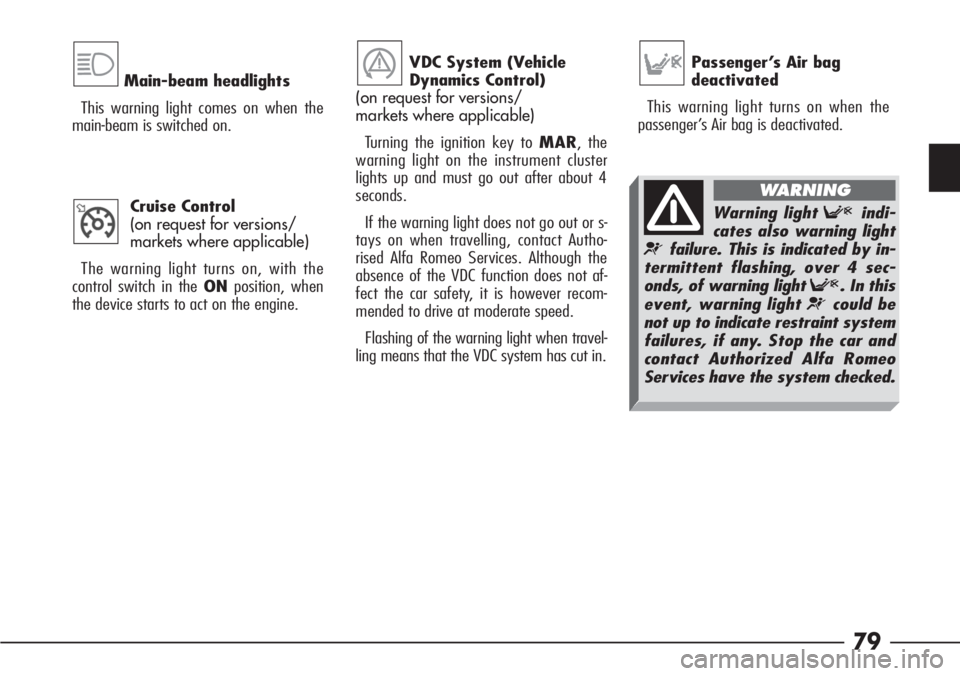
79
Main-beam headlights
This warning light comes on when the
main-beam is switched on.
Cruise Control
(on request for versions/
markets where applicable)
The warning light turns on, with the
control switch in the ONposition, when
the device starts to act on the engine.
1VDC System (Vehicle
Dynamics Control)
(on request for versions/
markets where applicable)
Turning the ignition key to MAR, the
warning light on the instrument cluster
lights up and must go out after about 4
seconds.
If the warning light does not go out or s-
tays on when travelling, contact Autho-
rised Alfa Romeo Services. Although the
absence of the VDC function does not af-
fect the car safety, it is however recom-
mended to drive at moderate speed.
Flashing of the warning light when travel-
ling means that the VDC system has cut in.
áPassenger’s Air bag
deactivated
This warning light turns on when the
passenger’s Air bag is deactivated.
Warning light Findi-
cates also warning light
¬failure. This is indicated by in-
termittent flashing, over 4 sec-
onds, of warning light F. In this
event, warning light ¬could be
not up to indicate restraint system
failures, if any. Stop the car and
contact Authorized Alfa Romeo
Services have the system checked.
WARNING
Page 93 of 272
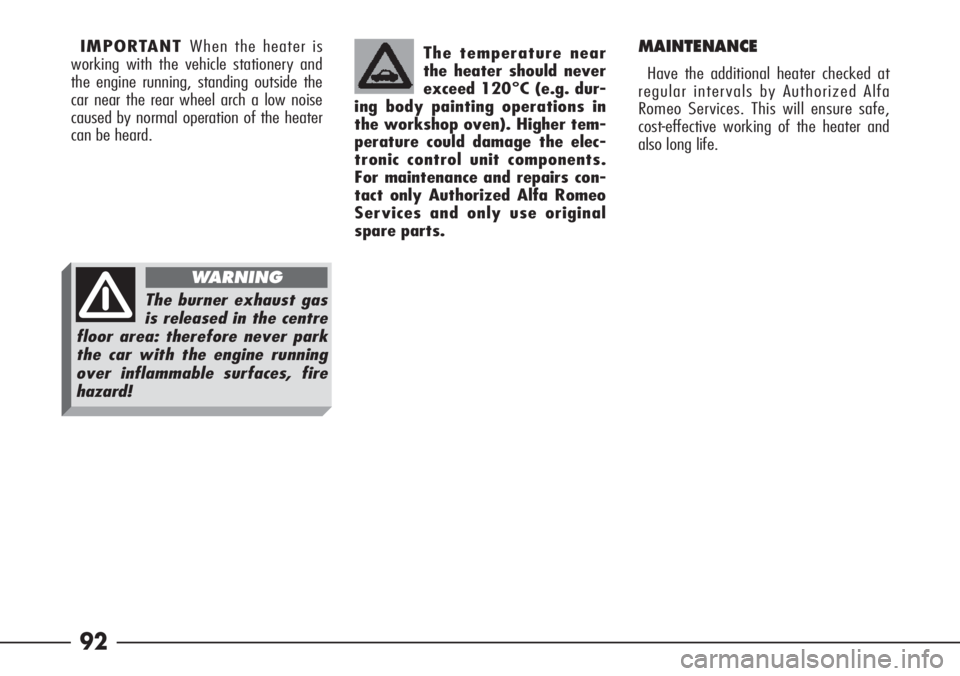
92
The temperature near
the heater should never
exceed 120°C (e.g. dur-
ing body painting operations in
the workshop oven). Higher tem-
perature could damage the elec-
tronic control unit components.
For maintenance and repairs con-
tact only Authorized Alfa Romeo
Services and only use original
spare parts.
The burner exhaust gas
is released in the centre
floor area: therefore never park
the car with the engine running
over inflammable surfaces, fire
hazard!
WARNING
IMPORTANT When the heater is
working with the vehicle stationery and
the engine running, standing outside the
car near the rear wheel arch a low noise
caused by normal operation of the heater
can be heard.MAINTENANCE
Have the additional heater checked at
regular intervals by Authorized Alfa
Romeo Services. This will ensure safe,
cost-effective working of the heater and
also long life.
Page 110 of 272
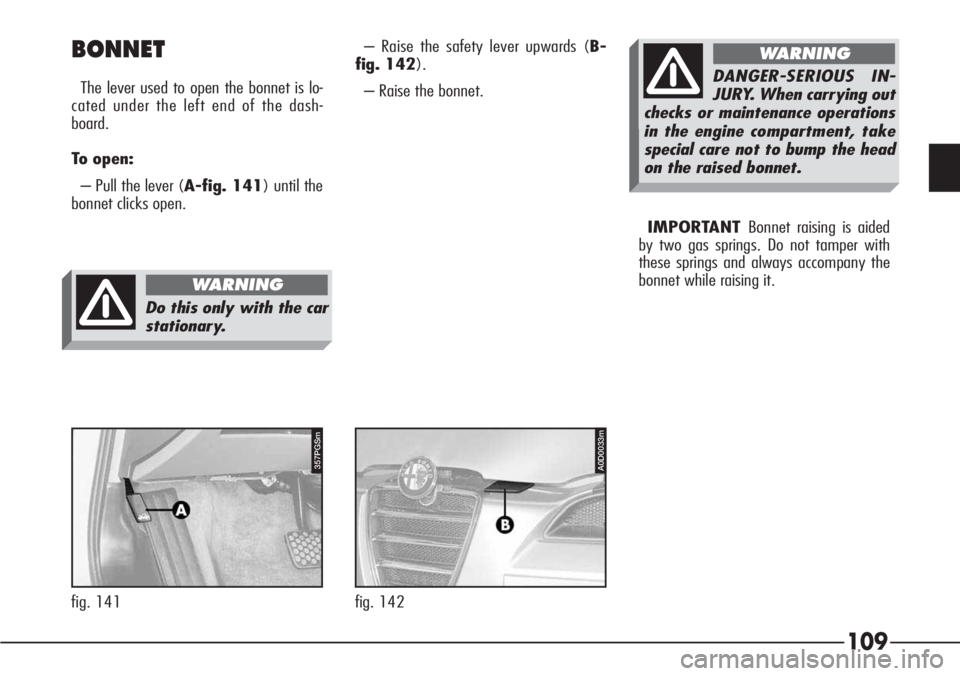
109
BONNET
The lever used to open the bonnet is lo-
cated under the left end of the dash-
board.
To open:
– Pull the lever (A-fig. 141) until the
bonnet clicks open.
357PGSm
fig. 141
Do this only with the car
stationary.
WARNING
– Raise the safety lever upwards (B-
fig. 142).
– Raise the bonnet.
IMPORTANT Bonnet raising is aided
by two gas springs. Do not tamper with
these springs and always accompany the
bonnet while raising it.
A0D0033m
fig. 142
DANGER-SERIOUS IN-
JURY. When carrying out
checks or maintenance operations
in the engine compartment, take
special care not to bump the head
on the raised bonnet.
WARNING
Page 111 of 272
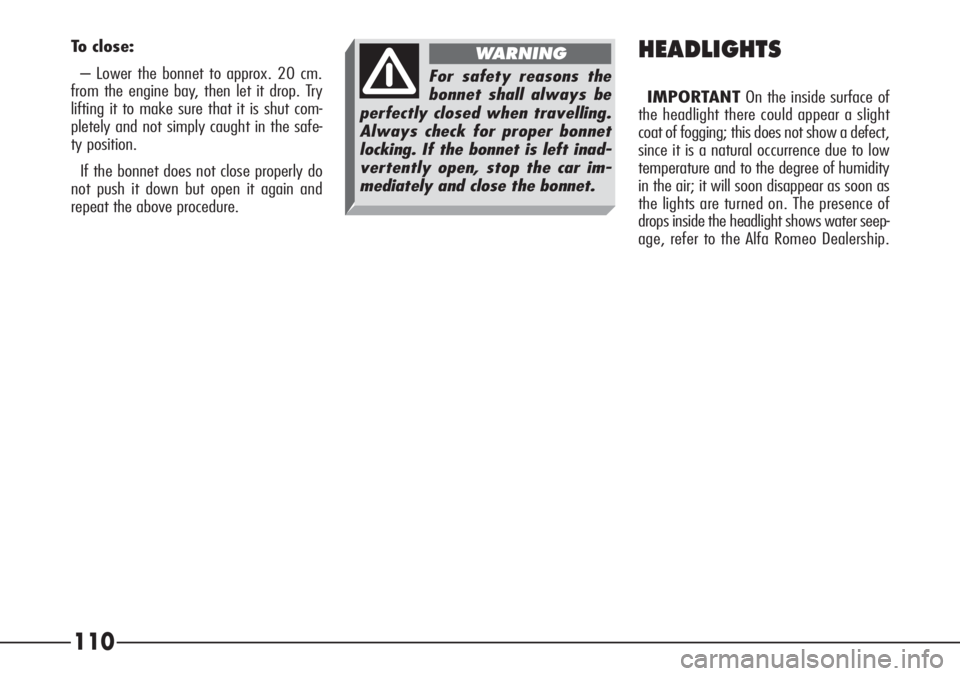
110
To close:
– Lower the bonnet to approx. 20 cm.
from the engine bay, then let it drop. Try
lifting it to make sure that it is shut com-
pletely and not simply caught in the safe-
ty position.
If the bonnet does not close properly do
not push it down but open it again and
repeat the above procedure.HEADLIGHTS
IMPORTANTOn the inside surface of
the headlight there could appear a slight
coat of fogging; this does not show a defect,
since it is a natural occurrence due to low
temperature and to the degree of humidity
in the air; it will soon disappear as soon as
the lights are turned on. The presence of
drops inside the headlight shows water seep-
age, refer to the Alfa Romeo Dealership.
For safety reasons the
bonnet shall always be
perfectly closed when travelling.
Always check for proper bonnet
locking. If the bonnet is left inad-
vertently open, stop the car im-
mediately and close the bonnet.
WARNING
Page 114 of 272

113
EOBD SYSTEM
(optional for versions/
markets where applicable
)
The EOBD system (European On Board
Diagnosis) allows continuous diagnosis of
the components of the car correlated with
emissions.
This system continuously monitors the
components of the vehicle related to e-
missions; it also indicates, when the
Uwarning light comes on on the instrument
panel, that the components in question
are in poor condition.
IMPORTANTAfter the problem has
been resolved, to completely check the
system, the Alfa Romeo Authorized Ser-
vice Station must carry out tests on a test
bench and, if necessary, road tests that
could be long.If, when the ignition key
is turned to MAR, the
Uwarning light does
not come on or if, when driving, it
lights up and emits a fixed light
or a flashing one, contact an Alfa
Romeo Authorized Service Station
as soon as possible. Warning
light
Uoperation can be checked
by means of special equipment
by traffic agents. Always comply
with the traffic regulations in
force in the country where you
are travelling.
The objective is the following:
– to keep under control the efficiency of
the system;
– to warn when a fault causes emission
levels to increase;
– to indicate the need to replace the
deteriorated components.
The system also has a diagnostic con-
nector that can be interfaced with appro-
priate tools, which makes it possible to
read the error codes stored in the control
unit, together with a series of specific pa-
rameters for engine operation and diag-
nosis. This check can also be carried out
by the traffic police.
Page 116 of 272
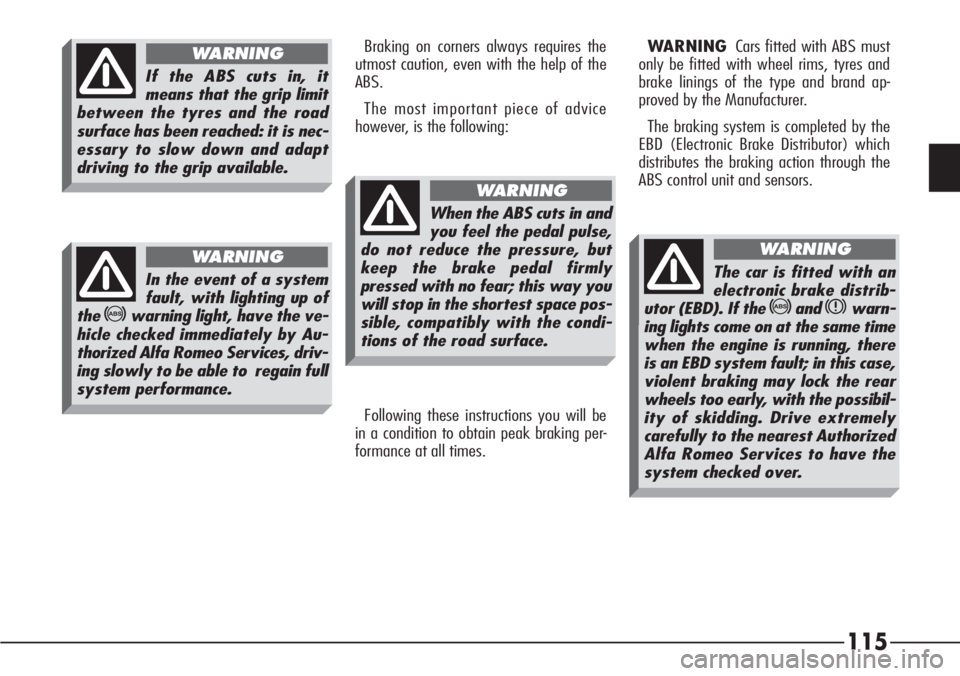
115
Braking on corners always requires the
utmost caution, even with the help of the
ABS.
The most important piece of advice
however, is the following:WARNINGCars fitted with ABS must
only be fitted with wheel rims, tyres and
brake linings of the type and brand ap-
proved by the Manufacturer.
The braking system is completed by the
EBD (Electronic Brake Distributor) which
distributes the braking action through the
ABS control unit and sensors.
Following these instructions you will be
in a condition to obtain peak braking per-
formance at all times.
If the ABS cuts in, it
means that the grip limit
between the tyres and the road
surface has been reached: it is nec-
essary to slow down and adapt
driving to the grip available.
WARNING
In the event of a system
fault, with lighting up of
the
>warning light, have the ve-
hicle checked immediately by Au-
thorized Alfa Romeo Services, driv-
ing slowly to be able to regain full
system performance.
WARNING
When the ABS cuts in and
you feel the pedal pulse,
do not reduce the pressure, but
keep the brake pedal firmly
pressed with no fear; this way you
will stop in the shortest space pos-
sible, compatibly with the condi-
tions of the road surface.
WARNING
The car is fitted with an
electronic brake distrib-
utor (EBD). If the
>andxwarn-
ing lights come on at the same time
when the engine is running, there
is an EBD system fault; in this case,
violent braking may lock the rear
wheels too early, with the possibil-
ity of skidding. Drive extremely
carefully to the nearest Authorized
Alfa Romeo Services to have the
system checked over.
WARNING
Page 117 of 272
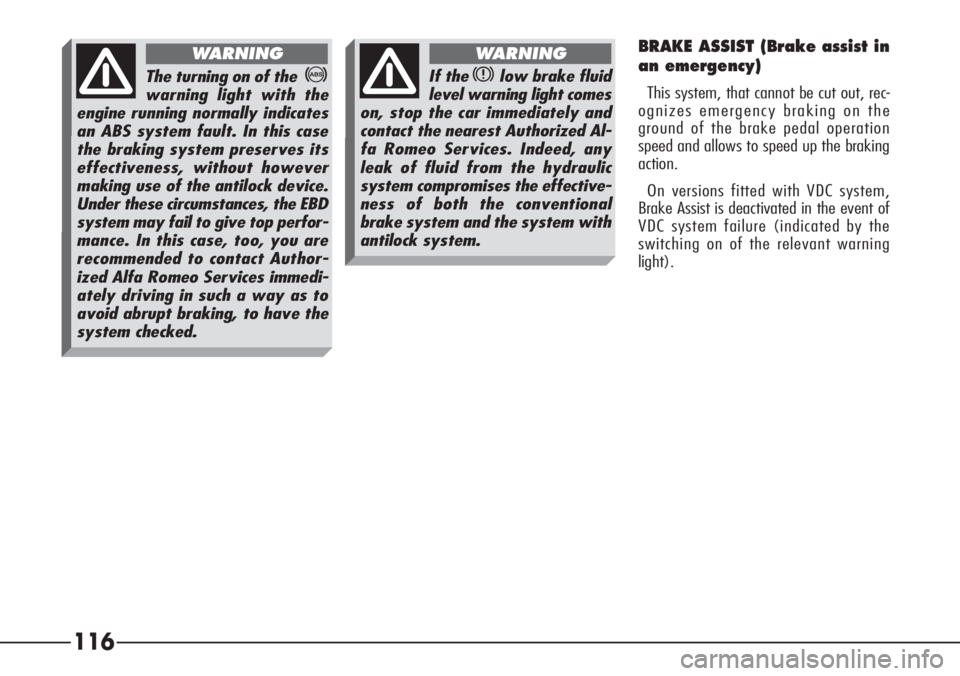
116
BRAKE ASSIST (Brake assist in
an emergency)
This system, that cannot be cut out, rec-
ognizes emergency braking on the
ground of the brake pedal operation
speed and allows to speed up the braking
action.
On versions fitted with VDC system,
Brake Assist is deactivated in the event of
VDC system failure (indicated by the
switching on of the relevant warning
light).
The turning on of the>
warning light with the
engine running normally indicates
an ABS system fault. In this case
the braking system preserves its
effectiveness, without however
making use of the antilock device.
Under these circumstances, the EBD
system may fail to give top perfor-
mance. In this case, too, you are
recommended to contact Author-
ized Alfa Romeo Services immedi-
ately driving in such a way as to
avoid abrupt braking, to have the
system checked.
WARNING
If the xlow brake fluid
level warning light comes
on, stop the car immediately and
contact the nearest Authorized Al-
fa Romeo Services. Indeed, any
leak of fluid from the hydraulic
system compromises the effective-
ness of both the conventional
brake system and the system with
antilock system.
WARNING
Page 122 of 272
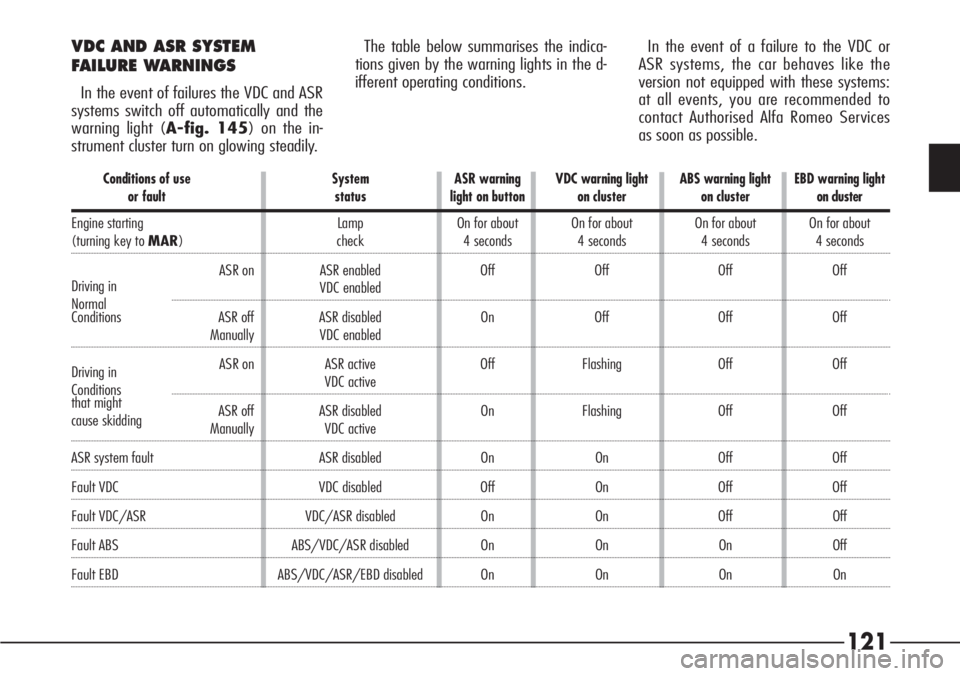
121
VDC AND ASR SYSTEM
FAILURE WARNINGS
In the event of failures the VDC and ASR
systems switch off automatically and the
warning light (A-fig. 145) on the in-
strument cluster turn on glowing steadily.The table below summarises the indica-
tions given by the warning lights in the d-
ifferent operating conditions.In the event of a failure to the VDC or
ASR systems, the car behaves like the
version not equipped with these systems:
at all events, you are recommended to
contact Authorised Alfa Romeo Services
as soon as possible.
Conditions of use System ASR warning VDC warning light ABS warning light EBD warning light
or fault status light on button on cluster on cluster on cluster
Engine starting Lamp On for about On for about On for about On for about
(turning key to MAR) check 4 seconds 4 seconds 4 seconds 4 seconds
Driving inASR on ASR enabled Off Off Off Off
NormalVDC enabled
Conditions ASR off ASR disabled On Off Off Off
Manually VDC enabled
Driving inASR on ASR active Off Flashing Off Off
ConditionsVDC active
that might
ASR off ASR disabled On Flashing Off Off
cause skidding
Manually VDC active
ASR system fault ASR disabled On On Off Off
Fault VDC VDC disabled Off On Off Off
Fault VDC/ASR VDC/ASR disabled On On Off Off
Fault ABS ABS/VDC/ASR disabled On On On Off
Fault EBD ABS/VDC/ASR/EBD disabled On On On On
Page 137 of 272
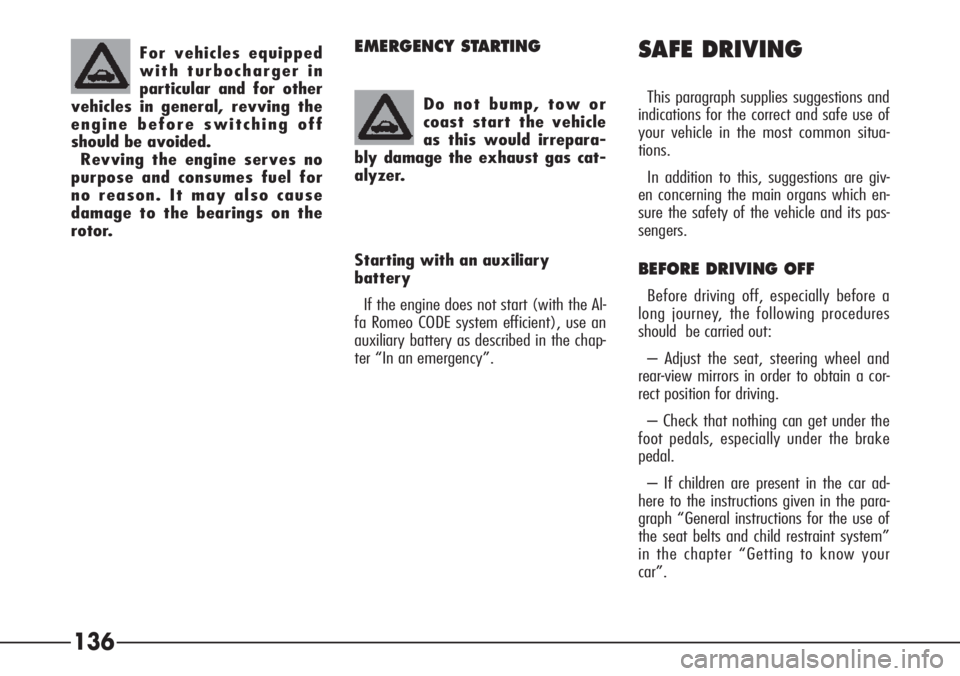
136
EMERGENCY STARTING
Starting with an auxiliary
battery
If the engine does not start (with the Al-
fa Romeo CODE system efficient), use an
auxiliary battery as described in the chap-
ter “In an emergency”.
SAFE DRIVING
This paragraph supplies suggestions and
indications for the correct and safe use of
your vehicle in the most common situa-
tions.
In addition to this, suggestions are giv-
en concerning the main organs which en-
sure the safety of the vehicle and its pas-
sengers.
BEFORE DRIVING OFF
Before driving off, especially before a
long journey, the following procedures
should be carried out:
– Adjust the seat, steering wheel and
rear-view mirrors in order to obtain a cor-
rect position for driving.
– Check that nothing can get under the
foot pedals, especially under the brake
pedal.
– If children are present in the car ad-
here to the instructions given in the para-
graph “General instructions for the use of
the seat belts and child restraint system”
in the chapter “Getting to know your
car”. For vehicles equipped
with turbocharger in
particular and for other
vehicles in general, revving the
engine before switching off
should be avoided.
Revving the engine serves no
purpose and consumes fuel for
no reason. It may also cause
damage to the bearings on the
rotor.
Do not bump, tow or
coast start the vehicle
as this would irrepara-
bly damage the exhaust gas cat-
alyzer.
Page 140 of 272
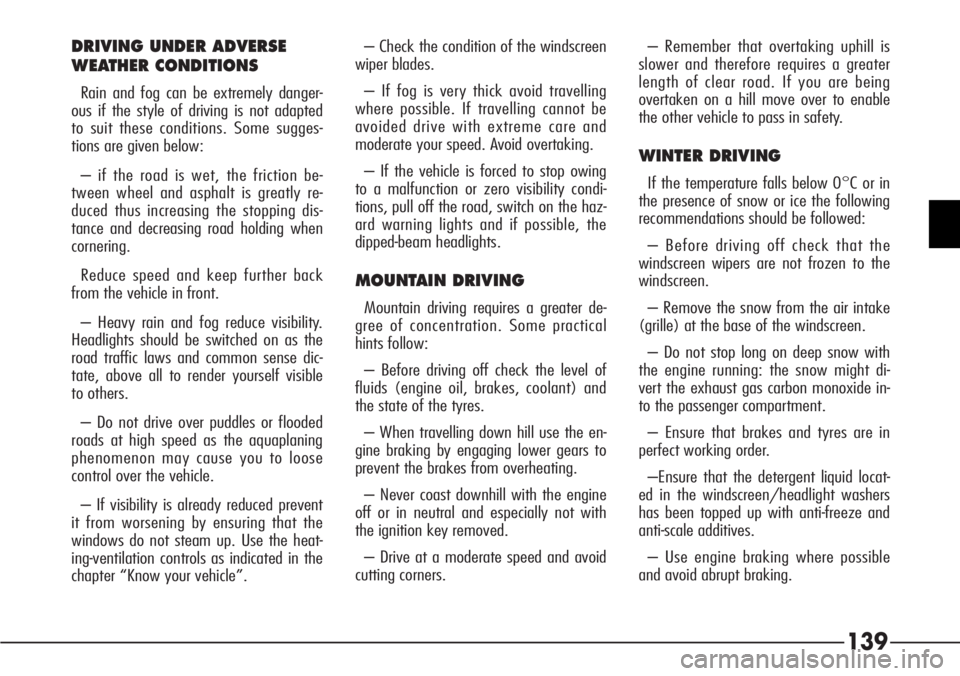
139
DRIVING UNDER ADVERSE
WEATHER CONDITIONS
Rain and fog can be extremely danger-
ous if the style of driving is not adapted
to suit these conditions. Some sugges-
tions are given below:
– if the road is wet, the friction be-
tween wheel and asphalt is greatly re-
duced thus increasing the stopping dis-
tance and decreasing road holding when
cornering.
Reduce speed and keep further back
from the vehicle in front.
– Heavy rain and fog reduce visibility.
Headlights should be switched on as the
road traffic laws and common sense dic-
tate, above all to render yourself visible
to others.
– Do not drive over puddles or flooded
roads at high speed as the aquaplaning
phenomenon may cause you to loose
control over the vehicle.
– If visibility is already reduced prevent
it from worsening by ensuring that the
windows do not steam up. Use the heat-
ing-ventilation controls as indicated in the
chapter “Know your vehicle”.– Check the condition of the windscreen
wiper blades.
– If fog is very thick avoid travelling
where possible. If travelling cannot be
avoided drive with extreme care and
moderate your speed. Avoid overtaking.
– If the vehicle is forced to stop owing
to a malfunction or zero visibility condi-
tions, pull off the road, switch on the haz-
ard warning lights and if possible, the
dipped-beam headlights.
MOUNTAIN DRIVING
Mountain driving requires a greater de-
gree of concentration. Some practical
hints follow:
– Before driving off check the level of
fluids (engine oil, brakes, coolant) and
the state of the tyres.
– When travelling down hill use the en-
gine braking by engaging lower gears to
prevent the brakes from overheating.
– Never coast downhill with the engine
off or in neutral and especially not with
the ignition key removed.
– Drive at a moderate speed and avoid
cutting corners.– Remember that overtaking uphill is
slower and therefore requires a greater
length of clear road. If you are being
overtaken on a hill move over to enable
the other vehicle to pass in safety.
WINTER DRIVING
If the temperature falls below 0°C or in
the presence of snow or ice the following
recommendations should be followed:
– Before driving off check that the
windscreen wipers are not frozen to the
windscreen.
– Remove the snow from the air intake
(grille) at the base of the windscreen.
– Do not stop long on deep snow with
the engine running: the snow might di-
vert the exhaust gas carbon monoxide in-
to the passenger compartment.
– Ensure that brakes and tyres are in
perfect working order.
–Ensure that the detergent liquid locat-
ed in the windscreen/headlight washers
has been topped up with anti-freeze and
anti-scale additives.
– Use engine braking where possible
and avoid abrupt braking.